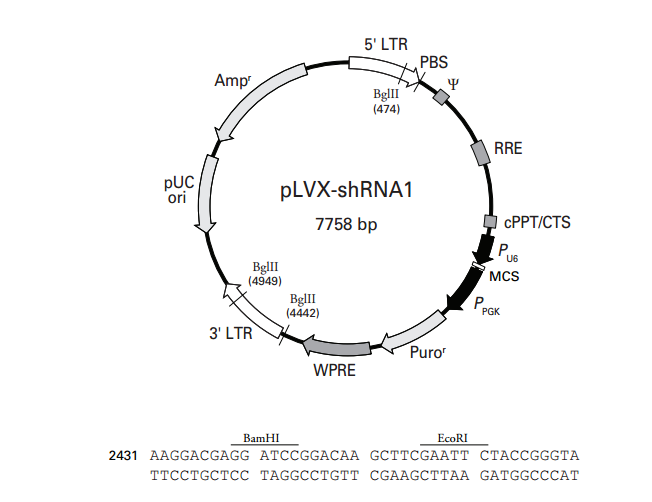
|
品牌 |
酶研生物 | |||||||||||||||||
货号 |
MY1456 | |||||||||||||||||
规格 |
2ug | |||||||||||||||||
价格 |
询价 | |||||||||||||||||
货期 |
现货 | |||||||||||||||||
描述pLVX-shRNA1 is an HIV-1-based, lentiviral expression vector designed to express a small hair-pin RNA (shRNA) for RNA interference (RNAi) studies. Expression of your shRNA is drivenby the RNA Pol III-dependent, human U6 promoter (PU6), located just upstream of the MCS. pLVX-shRNA1 can either be used as a plasmid expression vector and transfected into cells, or it can be packaged into viral particles and transduced into cells. Lentiviral particles derived from the vector allow the expression of shRNAs in virtually any cell type, including primary cells. pLVX-shRNA1 contains all of the viral processing elements necessary for the production of replication-incompetent lentivirus, as well as elements to improve viral titer and overall vector function. The woodchuck hepatitis virus posttranscriptional regulatory element (WPRE) promotes RNA processing events and enhances nuclear export of viral RNA (1), leading to increased viral titers from packaging cells. In addition, the vector includes a Rev-response element (RRE), which further increases viral titers by enhancing the transport of unspliced viral RNA out of the nucleus (2). Finally, pLVX-shRNA1 also contains a central polypurine tract/central termination sequence element (cPPT/CTS). During target cell infection, thiselement creates a central DNA flap that increases nuclear import of the viral genome, resulting in improved vector integration and more efficient transduction (3). In addition to lentiviral elements, pLVX-shRNA1 contains a puromycin resistance gene (Puror)under the control of the murine phosphoglycerate kinase promoter (PPGK) for the selection of stable transductants. The vector also contains a pUC origin of replication and an E. coli ampicillin resistance gene (Ampr) for propagation and selection in bacteria. 应用pLVX-shRNA1 is available in the Lenti-X™ shRNA Expression System (Cat. No. 632177). Before it can be transduced into target cells, the vector must be cotransfected into 293T cells with our Lenti-X HTX Packaging System (Cat. Nos. 631247 and 631249) and packaged into viral particles. This packaging system allows the safe production of high titer, infectious, replication-incompetent, VSV-G pseudotyped lentiviral particles that can infect a wide range of cell types, including non-dividing and primary cells (4).
|
|
|||||||||||||||||










